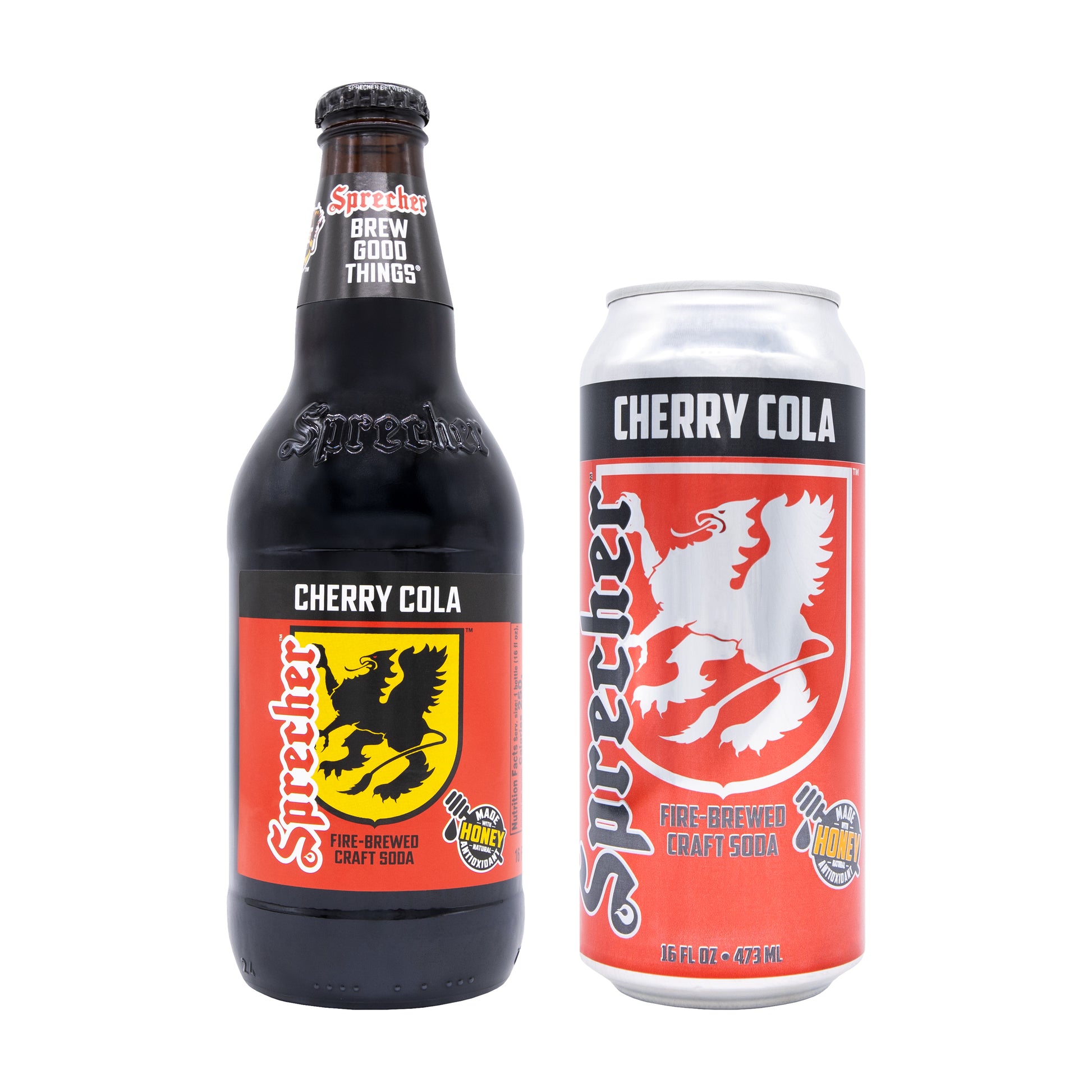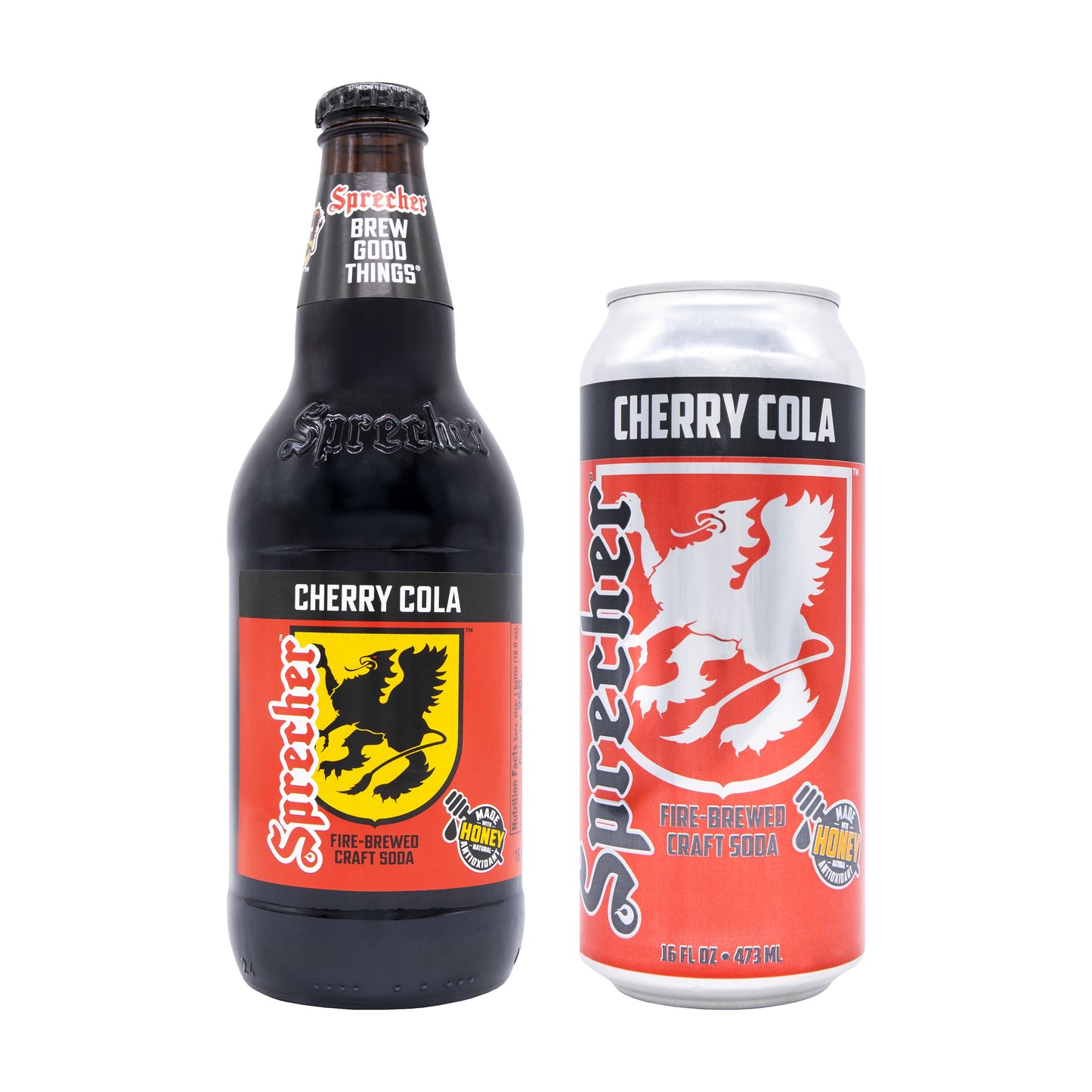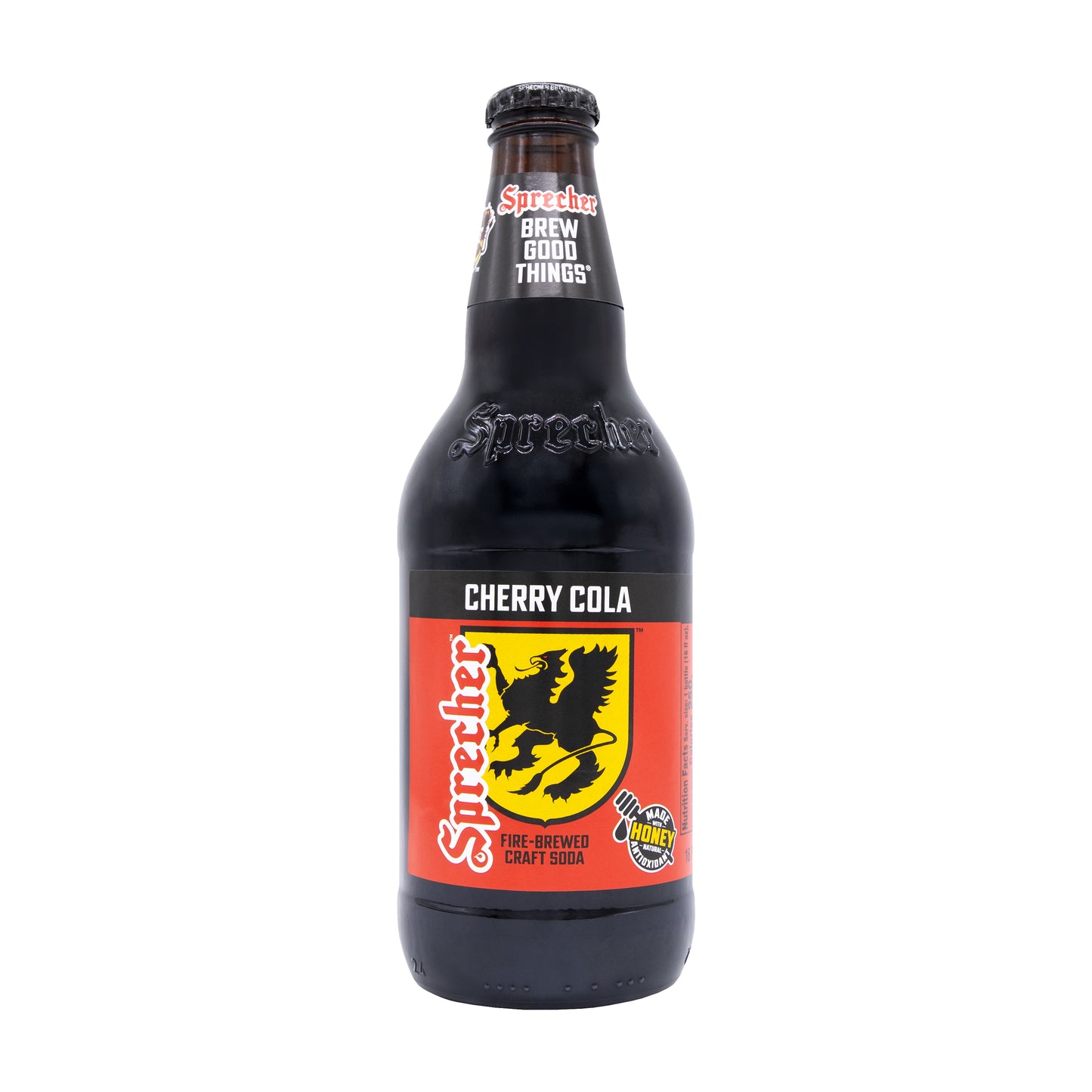This may come as a surprise, but cherry soda is weird, actually.
I know you don't believe me. In fact, the headline of this article asks a seemingly foolish question--why does Sprecher Soda use Door County Cherries? There's an easy answer, and you might already know it. Here's the easy answer:
Sprecher is a proud maker of fire-brewed craft sodas that use high-quality local ingredients. The orchards of Door County, WI grow some of the best cherries in the country, and those orchards are about a two-hour drive from Sprecher Brewery. The fine craft brewers of Sprecher wouldn't be doing their jobs right if they weren't using Door County cherries!
That's a great answer, and it explains why Sprecher Cherry Cola and Cherry Soda practically fly off the shelves. The Door County Cherry Juice in these sodas adds an enticingly complex blend of sweetness and tartness that makes these delectable brews head and shoulders above your average soda. Click here to try some cherry soda, or click here to try some cherry cola, and you won't regret your choice.

Sprecher Cherry Cola
Now that you've satisfied your sweet tooth, let me satisfy your curiosity--I am here to convince you that cherry soda is so weird that it's worth asking why it even exists. That argument begins with a little thought experiment.
The Big Four Flavors
Close your eyes and imagine that you are walking into a gas station--maybe a Kwik Trip, if you're a Wisconsinite like me--to pick up a bag of generic gummy candy. You buy the bag and pour some gummies into your hand. They're four different colors. Stop and think, I bet you can guess the colors before I tell them to you.
They're yellow, green, orange, and red, right? You put the red one into your mouth and start chewing. What does it taste like?
Most Americans would say--drumroll please--cherry, or maybe strawberry. That's because in the U.S., sweets are typically flavored lemon, lime, orange, and cherry/strawberry.

Green, Yellow, Orange, and Red Gummy Candy via Wikimedia Commons
It didn't have to be that way, and in other places, it isn't that way. As Canadian YouTuber and cultural commentator J.J. McCullough points out in this video, those "big four" (or five?) flavors are a product of the United States' unique food history.
Spice Candy and the Fruit Revolution
Back in the long ago when people mostly had to eat what grew nearby, part of the fun of sweets was that they would incorporate rare, intense, and exotic flavors.
Before the 1900s, lots of European and American candy was spice flavored--cinnamon, cloves, mint, or anise seed (aka black licorice) were all common candy flavors. Spices were exotic yet portable and shelf-stable, and a little spice went a long way. In a pre-refrigeration world, using spices to flavor sweets just made sense.

American candies used to be flavored using spices that Europeans viewed as exotic via Wikimedia Commons
Then, in the early 1900s, something strange happened: the fruit revolution. J.J. McCullough claims that a combination of better growing techniques, improved food storage, and superior supply chains allowed better fruit to get more people. Around the same time, refined sugar got really cheap.
In this brave new world, candy makers did what felt right--they combined newly popular fruit flavors with newly affordable refined sugar, and then they sold their fruit candy on the mass market. In the United States, the fruits that people loved the most turned out to be limes, lemons, oranges, strawberries, and cherries.
Why Cherries are the Odd Flavor Out in the Big Four
Cherries were not an obvious pick for winners of the fruit revolution in the United States. Compared to the other big four flavors, cherries are very high-maintenance.
Consider the other three flavors. Lemons, limes, and oranges are all relatively hardy fruits that can survive for a week or two at room temperature and up to a month in a cool, dark storage area. The citrus extract used by candy and soda makers as flavoring was made using citrus peels and high-proof alcohol, and it had a shelf life of up to four years.

Citrus fruits like lemons are much hardier and easier to preserve than cherries via Wikimedia Commons
Cherries, on the other hand, need to be eaten or preserved as soon as possible after picking. They only last for a couple of days at room temperature, and a week in ideal storage conditions--conditions that were expensive to create before refrigeration as we know it existed.
On top of that, cherries are not easy to grow. Cherries are not native to the Americas, but they have been around since Dutch settlers brought them over in the 1600s. However, the first commercially successful cherry orchard wasn't planted until 1893. That means nobody in North America made much money growing cherries for over 200 years. Why?
Why there was no Money in Cherries Before 1900
Put yourself in the shoes of a settler with pre-industrial farming technology. You have arrived (by foot or by pack animal) to a small plot of land and you have to decide what to plant. You need to grow food to feed yourself and your family, and if you have the space, you'll grow some cash crops to sell. Depending on when and where you are settling, you might have limited contact with other people, and limited ability to buy what you need. Now think about the pros and cons of growing cherries in that situation. Here's some helpful information to help you decide:
According to the Farmer's Almanac, tart cherry trees like those grown in Door County need to be planted 20-25 feet apart. Sweet cherry trees need to be planted 35-40 feet apart. If space is at a premium, that is a big investment in land.
You may think that's fine, you can just plant one cherry tree! Not if you want cherries. The trees are not self-pollinating, so you need to plant multiple trees, and you need to be sure they can pollinate each other.
Then, you need to plant the trees in an area with good air circulation, well-drained soil, and full sun. If you've done that, you're off to a good start, but those trees will still die if you're in most parts of the country.
The US Department of Agriculture defines 13 plant hardiness zones in the United States. The more zones a plant can grow in, the more tolerant it is of different temperatures. Tart cherry trees only grow in hardiness zones 4-6, and sweet cherry trees only grow in zones 5-7.

USDA map of plant hardiness zones via Wikimedia Commons
If you want to hedge your bets and plant both types of cherry tree, you need to be in zone 5 or 6. These zones are on a narrow strip of land that runs mostly through the middle of the U.S., so it's easy to miss.
Of course, if you're a European settler in the U.S., you just have to guess what zone you are in. You can't count on the USDA's help since it won't even exist until 1862. In 1862, which was the middle of the Civil War, the USDA wasn't exactly focused on cherry tree research--and they wouldn't be for decades to come.
Anyway, suppose you do everything right and you get some saplings sprouting up. Now, you have to wait a minimum of four years for the trees to mature while you fight off pests and disease. Once the trees mature and fruit, your real work begins.
Your real work is battling birds and squirrels until your cherries are ready to pick. Then, you have to hand-pick 50 to 100lbs of cherries off of each tree during the hottest part of summer. Be careful not to fall off the trees! Fixing broken bones is a nightmare before modern pain medications, assuming you can even find a doctor who knows what they are doing.
But now you have a couple hundred pounds of cherries, so you're almost across the finish line. All that's left is to eat or preserve them before they spoil in a couple of days! Have fun making jams, jellies, and preserves in August using a coal- or wood-fired stove in a kitchen with no air conditioning.
Now that you know what it took to grow cherry trees in the 1800s, do you think you would you do it?
If you're like most people, you might grow a small amount if you had time and land to spare, but you certainly wouldn't go into the cherry business.
What Changed? How the Commercial Cherry Industry took Over Door County
Three big changes in the early 20th century shook up cherry farming forever--a growing academic interest in farming, greater industrialization in agriculture, and a new taste for maraschino cherries. These changes transformed the cherry from a temperamental luxury crop to a staple flavoring for candies, sodas, and sweets. Door County, WI was one of the first places impacted by these changes.
Door County is a pretty bad place to grow most crops, as cherry growers readily admit in this video from Destination Door County, the County's tourism organization. The soil is rocky and it takes a long time for spring weather to arrive compared to other parts of the state. These conditions kill just about every crop that is useful to people.

A map of soil quality in Door County from 1910 noting an abundance of sandy soil, rock, and muck via Wikimedia Commons
Settlers of Door County found that the only plant they had much success with was apple trees. This drew some fruit growers to the region, but Door County didn't have much going for it until the University of Wisconsin's Horticulture Program took an interest.
The UW Horticulture Program planted a suite of experimental crops and found that cherries grew extremely well in the region. In years before, this would have been a bit of a bust, but industrialization had made selling fresh cherries much more feasible.
Once there was academic proof that cherries grew well in Door County, corporations like the Sturgeon Bay Orchard & Nursery Company planted large orchards and used the rail system to haul fresh cherries to nearby cities and towns.
Investors in the area quickly realized that they could make even more money by building a cannery close to the orchards in order to mass-produce preserved cherries. So, the Fruit Growers Canning Company got together in 1918, and quickly opened the doors of the first cannery in Door County one year later.
How the Non-Alcoholic Maraschino Cherry changed Cherry Flavoring
Around the same time, a growing class of wealthy Americans could afford trips to Europe, and they were coming back from the continent with a taste for a niche Croatian treat--Maraschino Cherries.
According to the Spruce Eats, Maraschino Cherries originated on Croatia's Dalmatian Coast. Croatians grew tart marasca cherries and packed them in Italian maraschino liqueur as a preservative. These cherries were then used in pastries, desserts, and drinks.

European-style Maraschino Cherries via Wikimedia Commons
In the 1920s, Oregon Agricultural College professor Ernest H. Wiegand adapted the recipe for prohibition-era America by replacing the then-illegal liqueur with sugar syrup. Wiegand's recipe also used a preservative that removed the color from the cherries, so his Maraschino cherries were injected with red dye, giving them an unnaturally bright-red look.

American-style Maraschino Cherries via Wikimedia Commons
Oregon farmers began using Wiegand's process to preserve their cherries, and the Americanized maraschino cherry quickly spread. As a result, the cherry became much more accessible and widely distributed, but only in a syrupy-sweet, fire-engine red presentation.
It is this idea of the cherry--the Americanized maraschino cherry--that candy makers began incorporating into their sweet treats. It was only natural that soda follow the same path.
Cherry Soda is Born
In 1917, the first Cherry Soda in the United States came together. During a sugar shortage in Salisbury, North Carolina, a businessman named L.D. Peeler bought a Wild Cherry flavoring from a St. Louis salesman and used it to create a cloyingly sweet cherry soda. He named the soda Cheerwine, and it rose to regional fame.
Throughout the 1920s, as the sweet maraschino cherry entered the scene, Cheerwine prospered alongside it, and imitators were swift to follow. As the decades went on, Americans came to expect cherry as a standard flavor for sweets and sodas, despite that fact that prior to the turn of the 20th century, the fruit looked like it had no shot at commercial viability.
The Cosmic Coincidence of Cherry Soda
Door County grew with the cherry industry, and when Randy Sprecher started making fire-brewed craft sodas in 1985, he probably never gave a second thought to creating a cherry soda with Door County Cherries. By that time, the choice just seemed obvious.

Sprecher Door County Cherry Soda in a Door County Cherry Tree
What's remarkable to me, and now (hopefully), to you, is the incredibly unlikely sequence of events that made Randy's decision a no-brainer. Think about it:
The Dutch brought cherries across the Atlantic in the 1600s, and despite being a difficult crop, cherries were planted on the east coast and in the upper Midwest. Then, on the cold and rocky peninsula of Door County, the UW Horticulture program decided to invest in planting experimental crops despite the poor soil, only to find that cherries grew extremely well.
This would not have been a big deal, except for the fact that at that exact same historical moment, a wave of agricultural industrialization made it possible to rapidly harvest and ship fresh cherries to market for the first time.
But, demand for cherries would not have been high enough to invest in a big canning operation if not for American tourists developing an unexpected taste for Croatian preserved cherries. Without that canning operation, Door County may not have had the economic staying power to remain well-known in 1985 when Randy Sprecher opened his brewery.
Plus, Americans might have had little interest in a sweet cherry soda if not for the fact that the namesake preservative in maraschino cherries became illegal shortly after they became popular, inspiring an Oregon professor to invent the sweet and unnaturally red maraschino cherry that Americans know and love.
It was likely (in part) the popularity of the Americanized maraschino cherry, with its syrupy sweet flavor profile, that paved the way for the newly invented Cheerwine soda to spread beyond the small world of Salisbury, North Carolina into the rest of the southeast and Appalachia, inspiring imitators that achieved national reach.

It's this incredible chain of coincidences that made Door County Cherry Cola and Door County Cherry Soda no-brainers for Randy Sprecher. Now, I have a no-brainer for you: click here to get started with a 12 pack of Cherry Cola and thank your lucky stars that you're a part of the unlikely timeline where cherries made it big.
Always stay in the know by joining our mailing list, and get the first access to our new craft sodas, craft beer and deals on apparel and gift shop items. Sign up today.





















